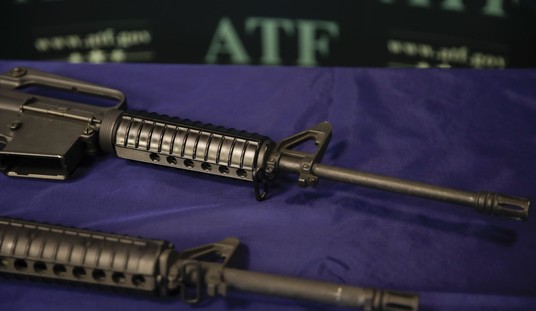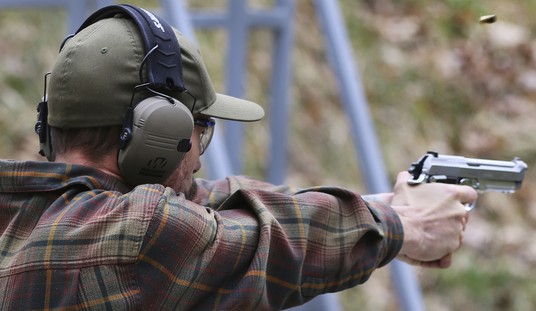Other articles in the series:
Back to Gunfighter School: Gunsite 350 Intermediate Pistol
Gunsite 350 Pistol: Shoot and Move and Steel!
DEATH IN THE OFFICE: Force-On-Force Training At Gunsite
Force-On-Force Non-Standard Response (NSR)
Gunsite: Indoor Simulators

It’s relatively easy to build up a false sense of confidence in your defensive firearm skills on a square range shooting at stationary targets from a fixed position. Things get a bit more interesting, however, when we start incorporating movement, and encountering targets hidden in rugged real-world terrain.
At the Gunsite Academy 350 Intermediate Pistol course we had the opportunity to put our skills to the test not just on square range, but in indoor simulators both during the day and at night, in force-on-force training against other human beings with Simunitions, and in day and night runs through outdoor simulators.
In our 350 Intermediate Pistol course, we ran through two different outdoor simulators, starting with the Donga.

The Donga at Gunsite is an outdoor simulator run through a wash formed by periodic flash flooding in the high desert. The floor of this particular ravine is relatively level, but is covered in a mix of sand, clay and loose rocks ranging in size from gravel to grapefruit, making for treacherous footing. Brush and bushes and small hills run through the length of the Donga, often obscuring deep cuts in the earth to the left and right extending yards into the surrounding hillside.
It’s the perfect place for an ambush… and you have to clear it.
Did I mention that there are “no shoots” hidden along the course of fire?
Here’s what an “easy” Donga run looks like, with a student in the 250 Pistol course filmed several years ago.
It didn’t look too bad, did it?
The targets were at what appeared to be normal pistol engagement ranges, occurred in relatively predictable places once you got a feel for things, and the steel targets were set to go down with a single hit.
Yeah… we weren’t that lucky.
It’s Walt’s World
Walt Wilkinson did 30 years in the U.S Army, including 26 years in Special Forces, retiring at the rank of Sergeant Major. I’m semi-convinced that every cunning, hard-edged character Clint Eastwood has ever played has been based on Walt’s life.
How tough is Walt?
He once pulled a pin on a live fragmentation grenade and dropped it into the fox hole he was standing in just to make a point to some foreign troops he was training. Yes, the grenade went off. No, it didn’t dare injure him (if you want the entire story, you’ll have to enroll in a class at Gunsite and ask him to tell you then entire story during lunch or on a water break).
Walt had higher expectations of his 350 Intermediate Pistol students than he would students in a 250 pistol class, and he did everything possible to force us to force us to search for targets in the way he’d trained us. He also set many of the targets so that they’d have to take multiple hits before going down, and we were robustly encouraged to drive them to the ground with mutiple shots.
If you failed to do as you were taught, you’d be ambushed and “killed”… and I was, by the very first target on the course.
It went down like this.

When entering the Donga from the cut on the right, you first see a target to your left on the left side of the ravine beyond some bushes. If you look closely at the photo above, you can see the white-painted steel popper target just peaking out left of center.
I think everybody in our class successful engaged this target, which was some distance away (15-20 yards, depending on how tall you were and which line you took).

But this wasn’t the first target on the course.

The target in the middle of the course was deviously placed to draw your eyes downrange. Do you see the bush to the left in the photo above? There was a short steel popper target representing a prone enemy just on the other side, and most shooters weren’t engaging it until they were mere feet away, if they engaged it at all.
I was one of the “victims” of this target, because I assumed that the first target I saw was the first target, and I scanning left and right from that point. If I had been scanning near to far as I’d been trained, I would have seen the ankle-biter at my feet.
I was focusing further downrange, and the little bugger would have cleaned my clock if it had been a real enemy. The shooter above (Kim) did a much better job of scanning than I did, and she was able to engage the target in a timely manner.
It’s a humbling feeling to feel Walt’s hand clap down on your shoulder, and then see him point at the bad guy who just ambushed you from feet away, whom you never saw. It was a lesson I took to heart when we ran through another ravine, the North Draw, later in the week for score.
* * *
As nerve-wracking as the Donga was during the day, it was even more challenging in the dead of night.
Miles away from any major city in the high desert outside Paulden, Arizona, night offers up the kind of dark those of us who grew up “back East” just don’t get to see. Without all the light pollution of street lights, the stars seemed bigger and closer, and the Milky Way was brighter in the high desert.
The shadows in the Donga also seemed darker as a result, and my 500-lumen flashlight suddenly didn’t seem all that bright.
Moving in the dark outdoors and searching for targets with a visible light is an entirely different world than making a similar run in daytime, and it didn’t help that Walt brought us into a different stretch of the Donga than we saw during the day.
Light on—scan for targets—light off—MOVE.
Every time you fire up your light at night, you may as well hold up a sign that says, “I’m over here… shoot me!”
The trick to running through such a scenario is to scan an area as fast as your mind can process it and no faster, discern and engage shoot/and no-shoot targets as warranted in the area of your scan, turn off your light, and then move quickly to your next best area of cover, while attempting to discern your next likely threat area.
For what I hope are obvious reasons I couldn’t take pictures of a nighttime simulator run in the Donga, but I can say that my run was probably more exciting than that of the other students making the run that night.
After I identified my first target against the ravine wall and dropped it with a pair of shots (thank you, Harries technique), I was just cutting off my light when something jumped off the edge of the Donga above the target, hit the ground, and started to run.
I hit my light again and tracked the creature over my sights as it skittered among the rocks before it dove headlong into some brush.
“Pack rat,” Walt said simply as I sat in the darkest dark, scanning and listening as the creature scurried away. Then were on our way to the next target, illuminating, scanning, going dark, and moving again.
Like in the nighttime indoor simulator run, I found my multi-function flashlight to be a distracting pain in the butt, and it has half-convinced me that light designers who keep adding various bells and whiles and modes to lights don’t actually have to use them. I’m going to be soon putting my existing multi-mode light in a backup role, and switching to a momentary-on-only, single-mode-only light for daily carry. Simple is better.
The lessons I learned in the day and night Donga runs will serve me well in the future when it comes to conducting outdoor searches, as what we learned was as much about how to search and scan and truly see, as it was in how to move and shoot.
We didn’t have long to wait, to incorporate those “see, move, and shoot” elements, however.
Later in the week we were taken one at a time to the North Draw, a narrower, steeper ravine with more hiding places, and more cleverly hidden targets waiting to ambush us…








Join the conversation as a VIP Member